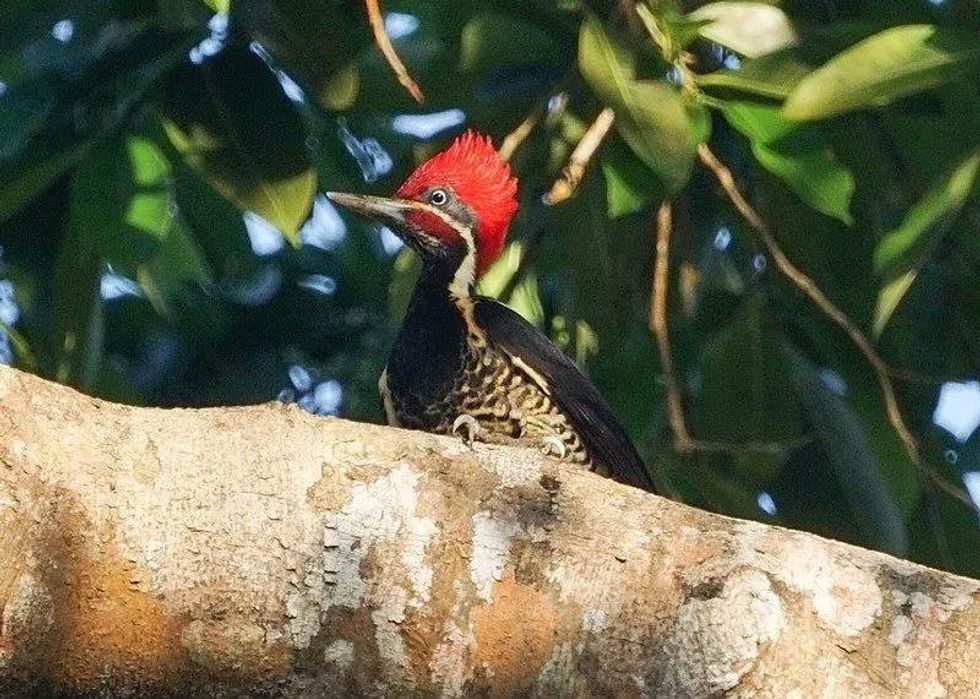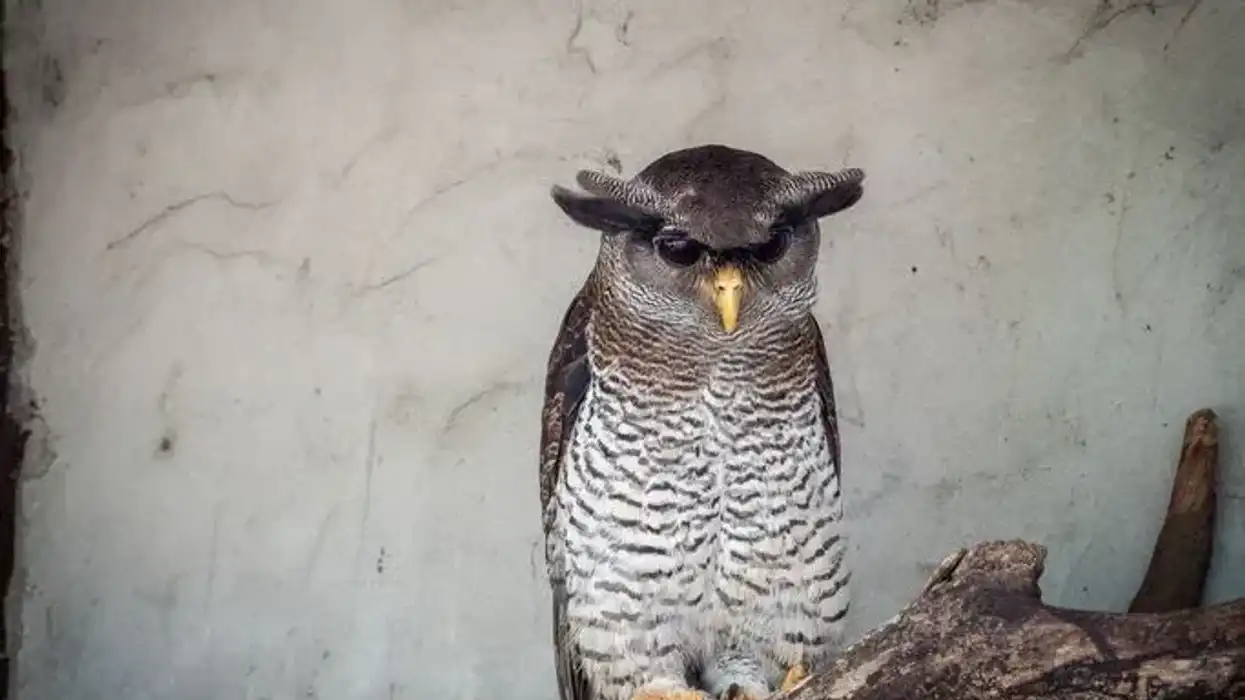The lineated woodpecker (Dryocopus lineatus) is large woodpecker species of the Picidae family. The lineated woodpecker was first described by French zoologist Mathurin Jacques Brisson in 1760.
He included the descriptions in his work, 'Ornithologie', based on a sample found in Cayenne, French Giana. Later in 1766, the Swedish naturalist Carl Linnaeus gave the species the binomial name Picus lineatus and also cited Brisson. The German naturalist Friedrich Boie introduced the genus Dryocopus in the year 1826.
The five subspecies of this bird are D. l. scapularis, D. l. similis, D. l. lineatus, D. l. fuscipennis, and D. l. erythropus. These woodpecker species are known for foraging on trunks and branches for insect prey.
The adult lineated woodpecker has a black top and underpants that are heavily barred with black.
This is where the bird's name comes from, as the word 'lineatus' is a Latin word that means 'lined' or 'marked with lines.' The breeding pair start living together as soon as the breeding season begins and lineated woodpeckers are known to closely resemble pileated woodpeckers (Dryocopus pileatus).
You may also enjoy our ivory-billed woodpecker and red-cockaded woodpecker facts.
Lineated Woodpecker Interesting Facts
What type of animal is a lineated woodpecker?
The lineated woodpecker (Dryocopus lineatus) is of the family Picidae and the Piciformes order. These birds are similar to the pileated woodpecker in their breeding behavior as these two species are closely related. They are also often confused with crimson-crested woodpeckers (Campephilus melanoleucos).
What class of animal does a lineated woodpecker belong to?
The lineated woodpecker (Dryocopus lineatus) is of the Aves class of animals.
How many lineated woodpeckers are there in the world?
The exact number of lineated woodpecker birds in populations around the world is not available.
Where does a lineated woodpecker live?
The lineated woodpecker (Dryocopus lineatus) mainly occupies North America and South America but they are not an endemic species. Their habitats range from southern Mexico to northern Argentina and Belize and Trinidad in the Caribbean. They are not migratory birds.
What is a lineated woodpecker's habitat?
The lineated woodpecker (Dryocopus lineatus) is found in a wide range of semi-deciduous forests and open woodland site habitats. They need fallen logs and standing dead trees in their habitat.
They are also found in dry forests, transitional forests, and humid forest site habitats, and in other sites with wood. They can also be found around the foothills of the Andes.
Who do lineated woodpeckers live with?
The lineated woodpecker (Dryocopus lineatus) can be found alone, in pairs, and sometimes in a flock of between five and six birds.
How long does a lineated woodpecker live?
The exact lifespan of the lineated woodpecker (Dryocopus lineatus) is unknown. However, a large woodpecker similar to this bird species can live anywhere around 11-15 years.
How do they reproduce?
Dryocopus lineatus is known to be a resident breeding bird. A breeding pair lives together throughout the breeding year.
During nest selection and courtship, they produce drumming or tapping sounds, and, depending on their geographical range, their breeding season changes. The usual breeding season is between February and April in Trinidad and Suriname, between March and April in Panama, and between April and May in Belize.
These birds excavate nests in a dead tree at 6.6-88.6 ft (2-30 m) above the ground. Both the male and female are involved in the excavation. The diameter of this excavation is 3.5 in (9 cm), and it is 18 in (45 cm) deep and 5.1-7.1 in (13-18 cm) wide.
Females produce a clutch range of between two and four eggs and both sexes take shifts to incubate the eggs. Only the male incubates the eggs at night.
The young chicks are fed through regurgitation by both the female and male every hour. The female mostly feeds the chicks while the male guards the nest.
What is their conservation status?
The conversation status of the Dryocopus lineatus is listed as Least Concern currently.
Lineated Woodpecker Fun Facts
What do lineated woodpeckers look like?
Dryocopus lineatus birds of the Piciformes order are a large woodpecker species. The description of these birds is similar to that of the pileated woodpecker.
These adult birds have a black top, a white stripe from the base of their bill, and a red crest. These white stripes extend down to their neck and shoulders, but the southeastern species lack these white lines.
The underpart of this bird is white and heavily barred black. When in flight, the wing looks white. The side of their head is black, and they have a red across their head stripe.
The adult male has a red line that extends from the bill to the throat and a red forehead. In an adult female, the plumage is black.
Both the female and male have a black bill, but sometimes, pale-billed lineated woodpeckers are also found. A red stripe is present on the cheek of a male but absent in a female and a young female bird of this species has dusky brown eyes.

How cute are they?
These birds are small with a red crest and white stripes on their underbelly. So, they are considered cute birds.
How do they communicate?
Dryocopus lineatus birds communicate using various calls. They use drumming as a defensive call and to communicate with the opposite gender. Sometimes they produce heavy-sounding flights too. They also use trapping, rapping, and high-call notes to communicate.
This high call note is also used to communicate with the other member of their breeding pairs. They also use the 'kay-rar-r-r-r' call note while excavating a nest. Other than communicating through different call sounds, they also do a bill-waving dance and partake in bill-touching.
How big is a lineated woodpecker?
The Dryocopus lineatus bird is 12.4-14.2 in (31.5-36 cm) long.
How fast can a lineated woodpecker fly?
Unfortunately, exact data on Dryocopus lineatus speed is not available.
How much does a lineated woodpecker weigh?
Dryocopus lineatus birds weigh between 0.29-0.21 lb (136-234 g).
What are the male and female names of the species?
There is no specific name given to male and female birds of this species.
What would you call a baby lineated woodpecker?
Baby Dryocopus lineatus birds are usually referred to as chicks.
What do they eat?
This Picidae family bird species feeds on insects, nuts, fruits, and seeds. They feed on ants, lizards, beetles, and larvae. On the other hand, these birds can be eaten by weasels, gray foxes, American martens, and squirrels.
Are they dangerous?
This bird species is not dangerous to human beings.
Would they make a good pet?
No. This bird species would not make a good pet. These birds are a wild species and are not friendly towards people. In some places in the world, it is illegal to own a woodpecker.
Did you know...
Crimson-crested woodpeckers (Campephilus melanoleucos) are similar to Dryocopus lineatus birds in plumage and size. This bird species also has a different description for both sexes. An adult male has an almost entirely red head while a female of this species has a broader light-colored face.
In the 18th and 19th centuries, the closely related pileated bird species lost most of their habitat due to the clearing of forests. This is a huge shame as these birds hold great meaning for many people; they are believed to signify determination and loyalty.
The smallest species of woodpecker is the piculet.
Why do pileated woodpeckers make holes in trees?
The pileated bird species make holes in a tree to find food. These holes are big enough to break a small tree in half! This bird species also created holes in trees with multiple entrances and these holes are also constructed to attract females and to raise young ones in.
Can a pileated woodpecker kill a tree?
As this bird species pecks on trees, these areas can become an entry point for any disease. If a woodpecker bird pecks on a tree extensively, it can sometimes girdle part of the tree. It can lead to cutting the flow of sap, which could kill the part of the tree above this damage.
Here at Kidadl, we have carefully created lots of interesting family-friendly animal facts for everyone to discover! Learn more about some other birds from our white-rumped sandpiper facts and white-rumped swallow facts pages.
You can even occupy yourself at home by coloring in one of our free printable Lineated woodpecker coloring pages.










